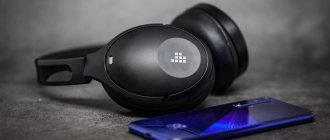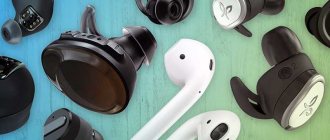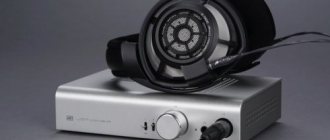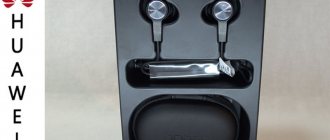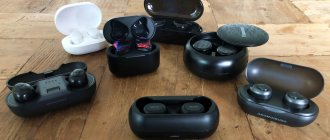Save and read later -
Today, headphones are without a doubt the most popular and numerous devices for reproducing sound. There are few people who do not have at least one pair of headphones, used if not with a music player, then at least with a mobile phone. However, the penetration of headphones into different areas of our lives was gradual. The first headphones began to be used at the end of the 19th century, dating back to the era of gramophones, long before the advent of acoustic systems of a modern look and design. However, the headphones of those years were different from modern ones; they were, first of all, practical devices intended for telephone operators, which is why they earned the literal name “headphones.” Headphones of a conventionally modern design were invented by Nathaniel Baldwin in 1910 and adopted by the US Air Force. The spread of headphones spurred the invention of radio, but the circle of their users was still small, including mainly military personnel and radio amateurs. Headphones equipped with high-quality dynamic drivers began to appear on the market starting in the 30s of the last century; legendary companies - the German Beyerdynamic and the Austrian AKG - became pioneers here. But most of all, the American company Koss contributed to the penetration of headphones into home audio systems, producing the first “headphones” with stereophonic sound in 1958. However, the final victory came to headphones in 1979, when Sony introduced the first portable Walkman player. With the progress of portable audio, for which “headphones” have become practically no alternative playback devices, headphones from offices, studios and homes moved to the streets and parks of cities, to public transport and outdoor travel, eventually capturing the whole world.
Headphones have become popular for a reason, but due to a number of advantages, the most obvious of which are compactness and mobility (they are easy to transport and most of them can be worn outdoors). In addition, headphones are personal, on the one hand, not disturbing others with loud sound, and on the other hand, partially or completely isolating the user from outside noise. The drivers of the headphones sit close to the ears, and they do not need to fill the entire room with sound, like traditional speakers. Therefore, headphones can be very effective, having very small emitters, freely reproducing deep bass from 20 Hz. The sound of the headphones is independent of room acoustics, best revealing the true character of the music recording. Headphones do not require the powerful amplifiers that traditional speakers require; many headphones can handle the amplifiers of handheld devices. Headphones have a low cost - if you compare the sound quality of headphones and speakers of a similar price, headphones will win in most cases.
100 years ago, such headphones designed by Nathaniel Baldwin were produced.
Among the relative disadvantages of headphones, one can note the reduced potential of sound dynamics in comparison with good speakers - they are inferior in the ability to “pump” the air, depicting a biting low-frequency blow. In addition, headphones often have difficulty constructing an accurate and natural musical scene - the images are grouped somewhere in the listener’s head, and the overall composition seems to be deformed. Problems with the scene can be solved either by using special amplifiers that mix a small part of another into the signal of one channel, or by using a special sound recording method (binaural), in which recording is made using two microphones built into a model of a human head. Naturally, such recordings are quite rare, since they are intended exclusively for headphones. Some manufacturers achieve a more natural position of the music stage by slightly turning the drivers so that the sound comes to the ears from the front. In addition, on the market you can find headphones with spatial sound, equipped with several differently oriented drivers for each earphone. It’s even easier to get surround sound using sound processor programs, which creates a three-dimensional effect even with simple headphones. However, their impressive and large-scale sound is more suitable for listening to soundtracks of movies and video games.
The modern headphone segment is very diverse, divided into several categories: by design, by acoustic design, by type of emitters, by additional functions and purpose. Without trying to cover the entire variety of headphones in one article, we will try to talk about the main types of “headphones” that are found on the Russian market.
Basic types of headphones
The types of headphones answer the question of how they fit on your head and on your ears. Over-ear headphones
, are equipped with a headband with large cups and ear pads that completely cover the ears. Headphones, by definition, do not put pressure on the ears, therefore they are considered the most comfortable among all types. The size of headphones does not limit designers from using large, high-quality drivers, so the vast majority of the best-sounding headphones are full-size. But large sizes can sometimes be a disadvantage; for example, outside the home and office, most music lovers prefer more compact models.
Full-size headphones completely cover the ears, on-ear headphones sit on top of the auricle
On-ear headphones
are not fundamentally different from full-size ones, but have smaller cups and ear pads, not covering, but overlapping the ears. Due to their lighter weight, many music lovers choose them to listen to music on the go, but this type of headphones puts a little pressure on the ears, causing some discomfort. But, unlike full-size models, on-ear headphones do not interfere with wearing glasses and large earrings. In addition, among on-ear headphones there are often fashionable designer models, distinguished by different colors and original shapes. These headphones are suitable for those who value individual style and like to stand out.
In-Ear Headphones
, similar in shape to drops, are placed in the auricle. Lightweight and very compact, these headphones do not provide uncompromising sound, but they are inexpensive and allow you to hear what is happening around, warning the user of possible troubles.
Earbuds are placed in the auricle, in-ear earbuds are inserted into the ear canal.
Those who want miniature headphones, but also excellent noise insulation coupled with high playback quality should pay attention to in-ear models
(“plugs”), which are inserted directly into the ear canal. However, for the best playback quality and comfortable use, in-ear headphones must match the diameter and shape of the ear canal as closely as possible, so users often have to select ear tips, purchasing, for example, additional foam tips. The most expensive models of in-ear headphones offer the option of individual production for the ears of the future owner. If the in-ear headphones do not fit perfectly in the ears, they will sound the same, especially in the bass area, causing discomfort during long listening sessions.
Wired
Such models provide a high level of sound quality. And, although the wire connected to the emitter plays a crucial role in the evolution of headphones, at the same time there was an improvement in the shape of the headphones, their design, and the cable used.
All types of headphones discussed above, with different types of housing design and regardless of the types of emitters used, are wired.
Acoustic design of headphones
The acoustic design of the headphones is related to the design of the cups: open type
- air from the back side of the emitter freely leaves the headphones through a cup, usually made in the form of a metal or plastic grille.
Closed type
- the rear speaker cup is sealed, creating an acoustic chamber in which the driver operates.
There is also a third type - semi-open
, where the emitter chamber is not completely closed, leaving a passage for air.
Open headphones
- lightweight, comfortable, with a neutral and airy reproduction character - in the absence of a rear camera, there is no place for body resonances to appear, coloring the sound. On the other hand, it is more difficult to get the deepest bass from open-back headphones, as manufacturers are forced to deal with the natural sensitivity drop of -6 dB/octave. In addition, open headphones almost do not cut off external sounds, are less protected from moisture and dust, and therefore are poorly suited for use in noisy places and outdoors.
On the left are open headphones, on the right are closed ones
Closed headphones provide increased sound insulation, cutting off external noise and preventing sound leakage to the outside. A closed camera without any problems allows you to adjust the playback to either increased bass output or even balance of playback. It is not for nothing that most monitor headphones for professionals have a closed design. On the other hand, on some closed models you can still notice a slight coloration of the body or a faint echo from the sealed chamber. When listening for a long time with closed headphones, your ears may overheat (sweat).
Semi-open headphones are an intermediate design; in terms of sound insulation and the nature of playback, they take more from the open or closed type, depending on the degree of sound permeability of the cups.
Rating of the TOP 12 best on-ear headphones 2021-2022
| Place | Name | Price |
| TOP 6 best wired on-ear headphones | ||
| 1 | Sennheiser HD 300 Pro | Find out the price |
| 2 | Sony MDR-XB550AP | Find out the price |
| 3 | JBL T450 | Find out the price |
| 4 | Sony MDR-ZX660AP | Find out the price |
| 5 | Beats EP On-Ear | Find out the price |
| 6 | Xiaomi Mi Headphones Light Edition | Find out the price |
| TOP 6 best wireless on-ear headphones | ||
| 1 | JBL T450BT | Find out the price |
| 2 | JBL Tune 600BTNC | Find out the price |
| 3 | Beats Solo3 Wireless | Find out the price |
| 4 | JBL E45BT | Find out the price |
| 5 | Sony WH-CH510 | Find out the price |
| 6 | JBL JR300BT | Find out the price |
Types of headphone emitters
Dynamic driver is the most common type of driver used in most headphones and traditional speaker systems. Dynamic drivers use a circuit with a fixed magnetic system, in the gap of which a moving voice coil connected to a diffuser is placed. In a magnetic field, an alternating force acts on a coil with alternating current, which begins to vibrate the coil, and with it the emitter diffuser. The advantages of dynamic radiators include technology that has been very well developed over decades, a wide range of operating frequencies, a large diffuser stroke and high output power. The disadvantages of the speakers are the relatively large mass of the moving system and the associated inertia of the diffuser, which limits the response speed with small changes in the signal, which makes it more difficult to achieve extreme detail in reproduction. The intrinsic resonances of dynamic emitters often lead to increased frequency response unevenness in the high frequency region.
Example of a dynamic headphone driver
Comparison of the operating principles of a dynamic and reinforcement emitter
Armature emitter
‒ a special class of drivers, widely used in in-ear headphones. The drivers use a metal U-shaped “armature”, one side of which is fixed, and the other, with a wound voice coil, is precisely centered in the gap of the field created by permanent magnets. The interaction of the electrical signal passing through the voice coil and the magnetic field causes the free part of the “armature” to move, and with it the driver diaphragm begins to vibrate. An armature driver is usually placed in a metal case that looks like a rectangular bottle, and the sound “pours” out through the neck. The advantages of an armature driver are that it can be made very small, the sound is detailed and fast, demonstrating good sensitivity, and allows you to work with low-power amplifiers. Disadvantages - small stroke of the membrane, which limits the maximum volume and operating range of the driver in the low-frequency region; non-linear dependence of impedance on frequency, which may cause compatibility problems with some amplifiers that have high output impedance. Some manufacturers get rid of the problem of limited bandwidth by using several drivers in one headphone, working together or in different frequency bands. But this path, while solving some problems, faces others - the presence of a crossover can lead to phase distortions of sound, the dependence of impedance on frequency becomes even more complex, reminiscent of the behavior of traditional multi-band speakers.
Hybrid in-ear earphone circuit
The limitation of the frequency range of one armature driver can be solved using an additional low-frequency band, which will be voiced by a dynamic driver. Such systems are usually called hybrid. The advantages of “hybrids” are obvious - a wide frequency band, detail and high sound dynamics across the entire spectrum. However, a competent combination of two dissimilar drivers in one system requires serious effort from engineers, plus the system cannot do without a crossover, which leads to the aforementioned nonlinearity of the frequency dependence of the impedance and problems with accurate phase matching of the drivers.
On the left is a typical planar driver membrane, on the right is a working model of isodynamic headphones from the main apologists of this direction - the Audeze company
Planar (isodynamic, orthodynamic) emitter
differs from a conventional speaker in that it has a flat diffuser - a very light, thin membrane, with “voice coil” tracks applied to it. Permanent magnets, usually made in the form of grids, are installed above and below the membrane. The denser the conductive tracks are applied, the better - the more uniform the force acting on the diffuser will be, and the less nonlinear distortions will be. The advantages of “planars” are natural and very detailed sound; minus - small stroke of the membrane, limiting the response at low frequencies. To improve bass reproduction, engineers are forced to use large-area drivers, which is why the most efficient and high-quality planar headphones are full-size.
Among the few companies promoting electrostatic headphones, the Japanese company STAX occupies a special place; on the right photo is their flagship - models SR-009S
Electrostatic emitter
similar in design to a planar driver, but uses a different principle. A thin membrane (usually mylar), charged from a high-voltage power supply, is suspended between two grid electrodes, to which an audio signal is applied. In an alternating electric field formed between the electrodes, the charged membrane begins to oscillate at the frequency of the sound signal. The minimum weight of the membrane and the uniformity of the force acting on it lead to the fact that electrostatic radiators have no equal in transmitting transient processes and sound detail. However, like “planars”, electrostatic emitters have a small membrane stroke and, therefore, require a large diffuser area. Another disadvantage of “electrostats” is that they require a special amplifier.
Additional headphone features
Headphones
have a built-in microphone. The microphone can be integrated into the cable, supporting the Hands Free function, desirable for those who use headphones with a smartphone. Or the microphone can be mounted on a rotating arm - a computer headset that can be used for work or in video games.
The microphone is integrated into the headphones for conversations: on the phone, Skype, video games, etc.
Remote control
- some headphones have a remote control on the cord, so the user does not have to reach into his pocket with a music player or phone every time to adjust the volume or switch tracks.
Active Noise Canceling Headphones
use a special electrical circuit. A tiny sensor detects external noise and feeds it to an analyzer circuit, which generates an electrical signal equal to, but out of phase with, the external noise. After this, the additional signal is mixed into the sound of the headphones, leveling out external interference.
Wireless headphones
are very popular because they are able to work without annoying, always tangled cables, and will be useful both on the street and at home. Wireless headphones can use different interfaces: Bluetooth, infrared frequencies, radio frequencies and Wi-Fi. All of the listed wireless interfaces have different communication parameters and subtleties that affect signal reception and performance. Among portable audio equipment, the leader in popularity is the Bluetooth interface, which implies a certain sound compression. Thus, the playback quality of wireless headphones will be slightly worse than that of wired models of the same class. However, to recognize the differences, you need to have fairly good hearing. Therefore, many users are more than satisfied with the sound of wireless headphones, especially if the headphones are used on a noisy street or at home to watch television programs or movies.
Modern wireless headphones are not necessarily large (with a headband and cups); there are many wireless in-ear headphones and earbuds on the market.
Active noise canceling headphones and wireless models use electronics that require batteries - rechargeable batteries or replaceable batteries, the charge of which must be monitored.
Selection rules
To choose among a large assortment of modern models the best on-ear headphones in all respects, you need to have a clear understanding of the main parameters, as well as determine in advance for what exact needs you are choosing the product. Don't look at the cost, which many consumers do, choose the type of device first.
It is the type that determines ease of use, and the sound quality greatly depends on it. Functional features are of no small importance, for example, Bluetooth (bluetooth - for those who do not know the correct pronunciation of this word), noise reduction systems, the presence of a standard “small Jack” connector and an adapter to a big Jack.
For wired over-ear headphones, the length of the wire is of great importance in order to ensure maximum comfort when working on a stationary PC, where the system unit is installed under the table and with a length of 1.5 meters the user will not be too comfortable. For wireless options, battery life without recharging is of great importance; for example, good and expensive models can work from 12 to 20 hours on a single battery charge.
There is no ideal option for all users in nature, because each individual has a different acuity of sound perception, so do not hesitate to check the product as much as possible on all parameters, try them on to feel the tightness of the ear pads. If this is not possible, because some products are sealed in plastic, then choose a well-known manufacturer of similar equipment that guarantees high quality and reliability.
Main technical characteristics of headphones
What technical parameters of headphones should you pay attention to? Sensitivity is the ratio of the volume level of the headphones to the level of the signal supplied to them from the amplifier, measured in dB/V or dB/mW. In principle, the higher the sensitivity of the headphones, the less power will be required from the amplifier to get good sound volume from the headphones. Accordingly, headphones with low sensitivity require more power from the amplifier and may not be suitable for portable music players.
An example of nonlinear impedance behavior of multi-driver armature headphones
Impedance
headphones - impedance, taking into account resistive and reactive (capacitive and inductive) components. There is a very wide range of headphone resistance values on the market, from units to thousands of ohms. Impedance is a tricky parameter and the number given in a headphone specification may refer to a specific frequency, while the actual impedance may be variable. According to Ohm's law, at the same voltage, the headphones will consume current depending on the resistance. Therefore, high-impedance headphones need an amplifier capable of producing a high output voltage, and low-voltage amplifiers in portable devices are less suitable for such headphones. Low-impedance headphones, for the most part, will work well with portable amplifiers. Another question is that impedance is not the only parameter that influences the choice of a headphone amplifier; sensitivity must also be taken into account. Therefore, in the group of dynamic headphones with average sensitivity, low-impedance headphones (suitable for “portables”) are considered to be headphones with an impedance of up to 32 Ohms, and at the same time, individual reinforcement models will sound with a good volume reserve, having an impedance of 100 Ohms.
If the audio system is represented as an electrical circuit, the output impedance of the amplifier will create a so-called voltage divider, which reduces the power output to the load (headphones). Therefore, it is desirable that the impedance of the headphones be much higher than the output impedance of the amplifier.
Typical frequency response of headphones, which will be subjectively perceived as close to uniform
frequency range
speaks of the spectrum reproduced by the headphones and, in principle, the wider it is, the better. However, in reality, the definition of the frequency range in headphones turns out to be too vague. Firstly, there are no standards in the world for measuring the amplitude-frequency characteristics (AFC) of headphones; everyone uses different stands, obtaining different results. Secondly, specifications often indicate frequencies of tens of kHz, but the range audible to the human ear extends only up to 20 kHz, and this is at best - with age, hearing sensitivity to higher frequencies steadily decreases. Although a very wide (uniform) operating band can be very favorably perceived by the amplifier. Thirdly, manufacturers usually do not indicate any tolerances, irregularities, or headphone frequency band measurements. And they can be understood. These are traditional speakers that create a sound field around the listener and are designed to produce as flat a frequency response as possible over as wide a frequency band as possible. As practice has shown, with headphones one has to take into account diffraction and interference of sound in the auricle and/or ear canal, as well as natural variations in the sensitivity of human hearing at different frequencies. For example, in a number of laboratories, when hardware testing headphones, corrections are used in the form of transfer functions HRTF (Head Related Transfer Function). But you need to understand that all these tricks are approximate, because each person has their own HRTF. Therefore, one can only focus on general approaches in measurements with caution. And lastly, the frequency range and frequency response of the assembled audio system can be significantly influenced by the matching of the resistance of the headphones and the amplifier.
What types of headphones are there and how to choose them correctly
I am sure that every music lover has faced the question of choosing headphones more than once. There are so many directions and varieties of which that it has become a real hell to navigate them. Today we will try to cover this topic in as much detail as possible.
Full-size, on-ear, in-ear or plug-in?
First you need to understand where exactly the headphones will be used. The type and class of choice of these devices depends on this. So, full-size models are simply ideal for home listening. But there is a subtlety here; they come in open and closed types. For quality, it is better to choose an open type, but in them you can hear everything that happens around you, and those around you can hear your music. That is, this is an option only for home and only when you will not disturb anyone and no one will disturb you. Yes, there are critically many restrictions. That is why advanced music lovers and recording studios use exclusively closed models. The downside is the reflection from the outer wall of the structure, but the upside is good sound insulation. It's like you're listening to speakers in a specially equipped studio.
On-ear headphones are much more mobile, but this segment has not been developing in any serious way for a long time. Most often they are marked with the word “DJ”, which only means a folding structure. DJ models have nothing to do with quality sound. I recommend, if possible, avoiding them, since they do not provide the correct pressure and coverage of the ear, which means your music will still be heard by others, and at the same time, they mostly have a closed design. Therefore, we collect all the disadvantages of each of these models. Plus one thing - slightly better mobility. But this is very controversial compared to the next segment.
The so-called “droplets” or “inserts” have recently become very popular. In essence, this is the same open model in a minimalist design. These come in both mediocre quality and audiophile level. They are very convenient to use, they are compact and do not require adjustment to the size of your ear canal. Although personally this class is not suitable for me at all, after them my ears begin to hurt in the places where there is contact with the body. I always recommend earbuds only to people who, for whatever reason, are not suitable for in-ear ones.
Over the past 10 years, in-ear headphones have progressed to a professional level. Every now and then in recording studios you can see musicians not in large “plugs”, but in compact “plugs”. In the bustle of the city, they also fit like no one else. But they have one important limitation: in order to evaluate the quality of their sound, it is important to choose the right attachments. Often, for example, I hear exclamations, they say, I bought it, but there is no bass. This is the first sign of incorrectly selected ear pads. In static mode, in-ear headphones should provide a good level of sound insulation. This, by the way, is their main disadvantage - you simply don’t hear what’s happening around you. That is, they are strictly not recommended for a cyclist or walking on the roadway. The issue is resolved only in wireless versions by means of additional microphones, from which the sound is mixed into your music.
That is, at home a good option would be full-size closed headphones, for places where it is important to quickly respond to the external environment - in-ear headphones, and for the metro and public transport - in-ear headphones. I myself prefer exclusively the latter.
Dynamic, isodynamic, hybrids or pure reinforcements?
Headphones are also divided into dynamic, isodynamic, reinforcement and electrostatic models. These are all different ways to position the emitter membrane in a magnetic or electric field. The principle of their operation is approximately similar.
People believe that isodynamic headphones sound better than their dynamic counterparts, but this opinion is long ago and very outdated. Unlike any planars, the dynamics have developed quite strongly in recent years. A great variety of different coatings have appeared that improve the speed characteristics of diffusers, or even they are made from completely non-trivial materials. As a result, today a good dynamic driver can easily outperform its isodynamic competitors. Which, by the way, also have their own small drawbacks. Typically associated with the edges of the range, that is, bass and treble.
If we consider the intra-channel segment, then in addition to dynamics and isodynamics there is a class of emitters such as fittings. Today this is the most promising type of emitters. Their main advantage is their small size and complete independence from the acoustic design of the chamber. That is, the speaker suffers greatly from all sorts of signal reflections inside the headphone body itself, and all this is alien to the fittings. Although, like isodynamics, they have exactly the same problems. It is extremely difficult to achieve high quality bass in fittings, as well as excellent high frequencies. American companies are actively working on these issues and have already partially closed the issue, but there is still no 100% success.
That's why so-called hybrid models appeared, where, with the help of a crossover, they combined the advantages of a dynamic driver for bass and an armature driver for mids and highs. It is very reasonable, you see, to simply assign the emitters to play the range in which they are strongest. In this case, little depends on the number of drivers; the main thing is to connect them correctly with each other.
Why not just use a quality speaker? - you ask. There are such models, but usually, if one range sounds excellent in them, then the other is no more than good. Creating an ideal driver is a very complex process and, as a rule, headphones with such a speaker cost more than a few hundred dollars, while with the help of hybrids similar results can be achieved at much lower costs, more predictable results and, as a result, at a lower price.
Regarding electrostatic drivers, which have recently appeared frequently in advertising photos, I recommend being careful. Initially, it is worth understanding that most of these are not electrostatic, but electret emitters and they are placed only at high frequencies, where they are most appropriate. Yes, this is better than any of the 30095 reinforcement bars, but I have never seen incredible quality among them. Perhaps, only for now - I won’t deny it.
Are high ohms the best?
There is also a popular belief in the resistance of wired headphones that the higher it is, the better the sound. And behind this opinion there are sound notes - it is better to choose headphones with the highest possible impedance. However, you should immediately understand that the tighter the headphones you choose, the more powerful the source will be needed. In my memory, a person purchased 600 Ohm headphones, and then was very sad when he realized that they simply needed a rather expensive amplifier.
The output power of your smartphone (about 25 mW) is enough for a maximum of 64 Ohms. If the model has a resistance of more than 200 ohms, then it is advisable to have at least 200 mW of output power, and better yet 500. That is, immediately figure out what you will connect them to and whether your source will handle the selected model.
For smartphones, you should definitely stick to a reasonable maximum of 64 ohms. And even less is better. For the player and DAC, study their characteristics to understand whether it is enough or not. From my own experience, anything above 200 Ohms requires an expensive player, an external amplifier, or even a completely stationary DAC. These headphones consume a fair amount of energy, so there’s not much to do with them in the portable segment.
Wired or wireless?
When I am asked a similar question, I guide people towards a different choice: quality or convenience? There is no doubt that headphones have become much more convenient without wires. In addition, wireless headphones have become completely decoupled from the analog part of the source. They no longer need an expensive audio player, since the headphones receive sound from the source in digital form and convert it into audio with their internal DAC, and then amplify it with their internal amplifier. That is, the DAC and amplifier of your smartphone or player are not used.
It seems convenient, you can choose headphones with the best filling and excellent emitters. However, due to the dimensions of the case, the quality capabilities of the converter are limited. And all this is also compounded by the shortcomings of the compression codecs used to transfer data between the smartphone and headphones. There is not enough current channel, which means we have losses. Overall detail and high frequencies suffer the most. That is why this range is often relegated to the background in wireless headphones. Moreover, this applies even to modern AptX HD and LDAC codecs.
In terms of music quality, Bluetooth now cannot compete with a wired connection at all. This is technically impossible. There are, of course, wireless models that are very successful in terms of sound, created taking into account all the shortcomings of the connection, but there are frankly few of them. Basically, the Bluetooth segment is aimed at the average, not particularly demanding music lover.
Active Noise Cancellation
Modern problems require modern solutions, which is why both wired and wireless headphones are widely equipped with active noise cancellation. Is it convenient? - definitely yes, especially on the subway or plane. Another question is what happens to the quality of the music. Usually all this is implemented by mixing a signal from a microphone in antiphase to it. That is, external noises seem to collapse, alas, with part of your music.
Consequently, active noise reduction is not about music addiction at all. And if all this happens in wireless headphones, where everything is far from ideal, then in the end we degrade the quality even more. Although, there are times when necessity outweighs aesthetics and active noise reduction is still vital. See for yourself here.
Playback delay
The issue of playback delay occurs only in wireless headphones and often when they are used for games. Most good videos are dubbed, so the words don't end up in the actor's mouth. But for games this is really important. But again, if you are going for a record, then no TWS will help you - use wires. And so, the more modern the codec, the lower the latency.
The exception is models with the so-called “game mode”, where they are reduced due to a shorter buffer. Just remember the dependence: lower latency means worse connection. Therefore, the game mode is not recommended for the street, and powerful modern codecs often switch to an adaptive communication mode themselves if there are problems.
Frequency response graphs
With the frequency response everything is very simple, if you like bass, then make sure that this range has a rise. If you don’t like ringing and sharp highs, it’s better not to have corresponding peaks. In any case, the frequency response is, of course, very important, but it can always be compensated for your own needs using an equalizer. So there is nothing directly critical here.
Afterword
As a result, I would like to emphasize that for maximum quality and minimal delays today you still need wired headphones. Wireless models, juggling a built-in DAC, an amplifier and emitters installed in the case, try to produce the clearest, most detailed sound across the entire range, but this is only an attempt to squeeze the most out of what is available. Regarding wireless codecs, it is best to have AptX HD or LDAC. So far they are not very common in the TWS segment, but some models are already available. Regarding AptX, it is not much better than the more common AAC. The difference here is rather in the implementation on a specific device. The best choices today are closed full-size and hybrid in-ear models. See noise reduction and sound transparency mode as needed. In general, highlight those characteristics that you need and what you, in principle, are willing to put up with. After which the choice of a specific model will become much more transparent.
Source



